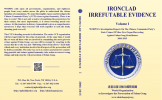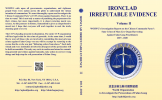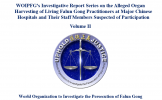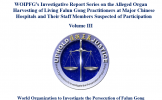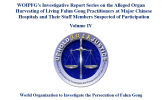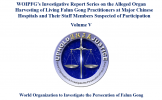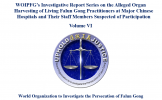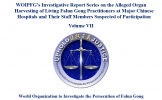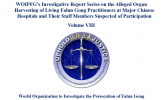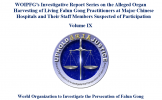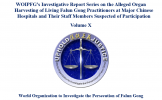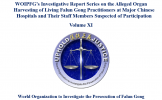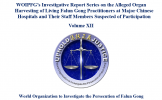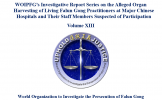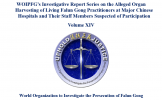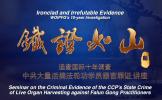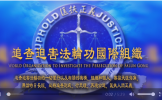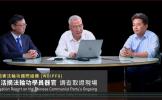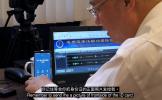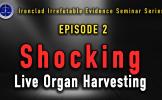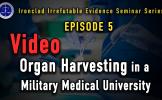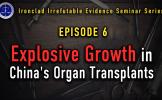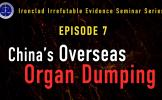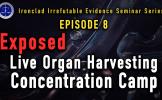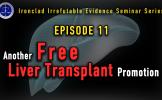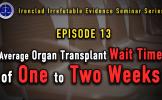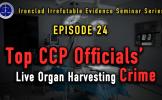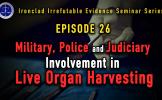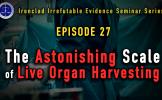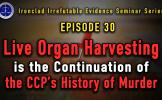Investigative Report on Former Vice Minister of Health, Huang Jiefu’s Alleged Unethical Medical Conduct in China
Abstract
Through the study of medical papers authored by Huang Jiefu, news reports on liver transplants performed by Huang and public statements made by Huang, this report presents data suggesting that Huang Jiefu has been involved in unethical transplant procedures and has misled the public with conflicting statements.
September 2005, Huang Jiefu went to China’s northwestern province of Xinjiang and performed an autologous liver transplantation at The First Teaching Hospital of Xinjiang Medical University in Urumqi. The transplant surgery was performed with two backup livers. Huang Jiefu requested the backup livers one day prior to the operation. Within 24 hours, a civil hospital in Guangzhou (2,651 miles away) and a military hospital in Chongqing (1,791 miles away) identified the matching “donors,” extracted the livers and transported the livers to Huang Jiefu’s operating room.
March 2013, Huang Jiefu said, “Last year [2012], I did over 500 liver transplants. The one done in Guangzhou in November [2012] used the first voluntary organ donation from a citizen.” This indicates that all liver transplants Huang Jiefu performed prior to November 2012 used livers that were not from voluntary donation. Two months later, in May 2013, Huang Jiefu said, “My own practice has not taken organs from prisoners for two years now.” This statement suggests that Huang Jiefu did not use executed prisoners’ organs since May 2011. If the livers between May 2011 and November 2012 were not from executed prisoners and not from voluntary donors, what kind of “donor” did the livers come from? If both statements from Huang Jiefu were true, the livers would have to come from involuntary, non-executed “donors.” This definition could apply to living prisoners of conscience.
According to medical research papers authored by Huang Jiefu, he transplanted livers from cadavers with only 30 seconds of warm ischemia time. It is impossible to have such a short warm ischemia time with organs from executed prisoners, the admitted primary source. Living donors are the only source that can provide conditions to allow such a short warm ischemia time. The research paper stated that the organs came from “brain dead” persons as early as 1999. However, China has never had a policy that defines brain death. The papers also state that, in 2004, there were organs from “voluntary donation.” The first donated organ reported by Chinese media was in 2006. The statements are conflicting and beyond scientific comprehension.
In conclusion, Huang Jiefu’s verbal and written statements at different times and locations are conflicting. While claiming that organs come from living donors, his statements do not address involuntary organ procurement from living organ sources. Without clear and concise explanation of the source, it is suggested that Huang Jiefu transplanted livers procured from living, non-consenting organ sources.
Index
1 About Huang Jiefu
2 Alleged violation of medical ethics in transplants conducted by Huang Jiefu
2.1 September 2003 in Changsha, Hunan province
2.2 September 2005 in Xinjiang province
2.3 November 2012 in Guangzhou, Guangdong province
3 Huang Jiefu authored medical papers with questionable content
3.1 Cadaver liver with warm ischemia time of 30 seconds
3.2 Voluntary donation in 2004
3.3 Brain dead “donors” before 1999
4 Issuing deceiving statements to hide unethical medical conduct in China
4.1 November 2006: Most organs were from donation after death
4.2 November 2011: Fifty eight percent of the total transplants use executed prisoners’ organs
4.3 March 2012: Executed prisoners are the main source of organs
4.4 March 2013: Number of executed prisoners decrease by 10 percent per year since 2003
4.5 Ending reliance on executed prisoners’ organs by counting prisoners as citizens
4.6 May 2013: “my own practice has not taken organs from the prisons for two years now”
4.7 March 2014: Use of executed prisoners’ organs without consent ongoing
5 Huang Jiefu’s active involvement in the persecution of Falun Gong
6 Conclusion
7 References
1 About Huang Jiefu
Huang Jiefu (*1946) was the President and Chinese Communist Party (CCP) Committee Chief at Sun Yat-sen University of Medical Sciences in Guangzhou from 1996 to 2001[1]. From October 2001 to March 12, 2013, Huang was China’s Vice Minister of Health[2]. During this time, Huang was also the director of China’s Organ Transplant Committee (since July 2006)[3], director of China Organ Donation Committee (since 2008)[4], director of China Organ Donation and Transplant Committee (since March 1, 2014)[5], honorary director at The First Affiliated Hospital, Sun Yat-sen University of Medical Sciences, and director of renal surgery department at Peking Union Medical College Hospital[6].
2 Alleged violation of medical ethics in transplants conducted by Huang Jiefu
As China’s Vice Minister of Health, Huang continued to conduct numerous liver transplants in various locations in China. The “donor” livers used were procured after very short waiting times and the sources of the organs were not disclosed. The following are examples of liver transplants conducted by Huang Jiefu, and were covered by State-run media as news.
2.1 September 2003 in Changsha, Hunan province
September 18, 2003, Huang Jiefu attended the opening ceremony of “Hunan Transplant Research Center” at the Third Xiangya Hospital of Central South University in Changsha, Hunan. There were seven liver and kidney transplants scheduled that day. Huang conducted a liver transplant on a 53-year-old liver cancer patient. According to the report by Xinhua, the major state-run news agency in China, the recipient checked into the Third Xiangya Hospital one week prior to the transplant surgery[7].
The liver recipient’s first visit to the hospital was only one week prior to the transplant surgery, indicating that the waiting time for the liver was less than one week; in addition, seven liver and kidney transplants were scheduled on the same day, concluding that the “donors” were already identified and the date of the transplant was selected.
2.2 September 2005 in Xinjiang province
Urumqi Online, ran by the biggest news outlet in Xinjiang province Urumqi Evening News, reported “a record breaking two liver transplants in 25 hours” on October 11, 2005[8]. The report stated that Huang Jiefu went to Xinjiang as a member of a delegation led by Luo Gan, then head of the CCP Central Political & Legal Affairs Committee (PLAC, the regime’s extra-judicial organization to implement the persecution of Falun Gong) on September 23, 2005. During his stay in Xinjiang, Huang conducted two liver transplants. The first was an autologous liver transplantation; the second was a living donor liver transplant between siblings. This report focuses on the autologous liver transplant.
On September 28, 2005 Huang Jiefu and Wen Hao, director of The First Teaching Hospital of Xinjiang Medical University, preformed a planned half liver surgery and discovered cancerous cells had spread. Huang Jiefu came up with an alternative plan to remove the patient’s liver, cut off the cancerous part, and transplant the liver back in, (i.e., autologous liver transplant). A healthy backup liver would be necessary if the autologous liver transplant failed. After some discussion, Huang Jiefu contacted The First Affiliated Hospital Sun Yat-sen University of Medical Sciences in Guangzhou, Guangdong province and Third Military Medical University Affiliated Southwest Hospital in Chongqing, Sichuan province, requesting a backup liver with the same blood type as the patient in Xinjiang. The next day (September 29), at approximately 6:30pm, a backup liver arrived at the operating room from Chongqing. Given a survival time of 12 hours to remain viable outside the body, the livers would need to be procured after Huang Jiefu requested it, otherwise the time frame of 24 hours would be too long for the livers to survive outside the body. This amounts to killing for transplant organs “on demand.”
Sina.com.cn, a major online news outlet, reported the same operation in an article dated October 3, 2005, titled “Our country’s first autologous liver transplant was successfully performed in Xinjiang[9].” It reported that on September 29, “three medical personnel arrived at the hospital in Xinjiang from Guangzhou. They brought a bypass device and a liver. The team in Xinjiang quickly found a matching backup liver.”
Huang Jiefu requested the livers from a military hospital and a civil hospital. Both hospitals were able to locate a liver with the matching blood type and transport them to Xinjiang the next day.
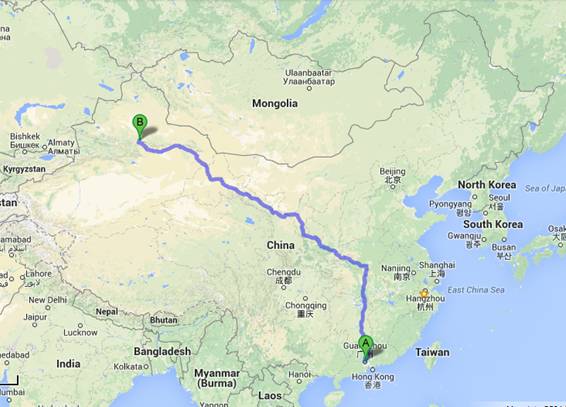
Figure 1. Within one day, a liver “donor” was identified; the liver was removed and transported 4,267 km (2,651 miles) from (A) The First Affiliated Hospital Sun Yat-sen University of Medical Sciences in Guangzhou to (B) Huang Jiefu’s operating room in Xinjiang.
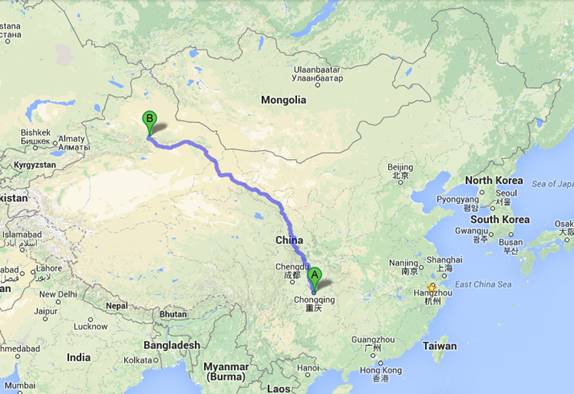
Figure 2. Within one day, a liver “donor” was identified; the liver was removed and transported 2,883 km (1,791 miles) from (A) The Third Military Medical University Affiliated Southwest Hospital in Chongqing to (B) Huang Jiefu’s operating room in Xinjiang.
2.3 November 2012 in Guangzhou, Guangdong province
In late 2012, while in Guangzhou for meetings, Huang Jiefu conducted three liver transplants. The first transplant was on November 21 at the Third Affiliated Lingnan Hospital, Sun Yat-sen University and, the second was on the following day at Guangzhou Military Region General Hospital. After the transplants were completed, Huang announced that he would perform another transplant at the First Affiliated Hospital, Sun Yat-sen University on November 23[10].
March 2013, Huang discussed the three operations mentioned above to Guangzhou Daily: “Last year [2012], I did over 500 transplant operations. The one done in Guangzhou in November was the first voluntary donation by a citizen[11].” Concluding that, of the 500 transplants Huang Jiefu performed in 2012, the liver used in November was the first voluntarily donated liver.
3 Huang Jiefu authored medical papers with questionable content
A search for medical papers coauthored by Huang Jiefu, yielded over 300 entries. The papers contained details about organ transplants with descriptions of the “donors” and the organ waiting times. Below are a few examples of the papers.
3.1 Cadaver liver with warm ischemia time of 30 seconds
The Chinese Journal of Surgery, January 2003, Vol.41, Issue 1 published an article titled “Prevention, diagnosis and treatment of biliary complications after liver transplantation.” Huang Jiefu was coauthor at the Organ Transplant Center, The First Affiliated Hospital, Sun Yat-sen University of Medical Sciences[12]. The paper describes 123 liver transplants performed between April 1993 and November 2001. The transplants used “cadaver livers” with a warm ischemia time between 30 seconds and 8 minutes!
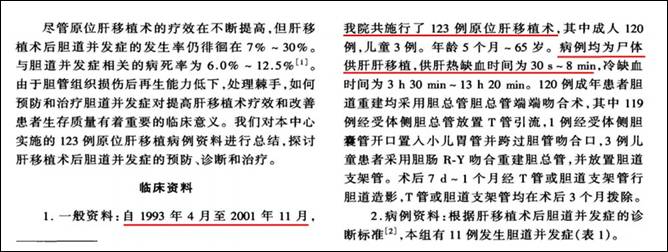
Figure 3. Excerpt of Huang Jiefu’s paper on Chinese Journal of Surgery, January 2003
To extract livers from human cadavers and to achieve the warm ischemia time of 30 seconds is medically impossible. The liver sources must be alive and the procurement must have been carried out under operating room conditions to achieve the 30 second warm ischemia time, ruling out the possibility that the extractions were done on the execution grounds. In absence of a voluntary organ donation system, a viable conclusion is that non-consenting living prisoners of conscience were killed in the process of liver removal in the operating room.
3.2 Voluntary donation in 2004
Chinese Journal of Clinical Nutrition April 2012, Vol.20, Issue 2 published an article titled “Perioperative nutrition support therapy for combined ‘en bloc’ liver/pancreas transplantation” Huang Jiefu was coauthor at the Organ Transplant Center, The First Affiliated Hospital, Sun Yat-sen University of Medical Sciences[13].
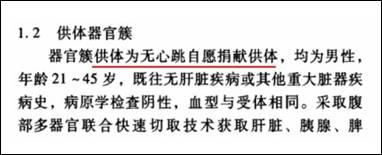
Figure 4. Excerpt of Huang Jiefu’s paper on Chinese Journal of Clinical Nutrition April 2012
The paper describes 10 liver-pancreas transplants performed between May 2004 and September 2010. The 10 “donors” were “voluntary donors with no heartbeat, all male, ages 21 to 45, no history of liver diseases and other large organ diseases.” The organ donation program promoted by Huang Jiefu started a trial in 2010 and began to operate in 2013. Huang Jiefu’s paper refers to voluntary donation as early as 2004. There is an inconsistency in the use of “voluntary” organ donation.
3.3 Brain dead “donors” before 1999
The Chinese Journal of Practical Surgery, May 2000, Vol.20, Issue 5 published an article titled “ABO incompatible liver transplantation.” Huang Jiefu was coauthor at the Organ Transplant Center, The First Affiliated Hospital, Sun Yat-sen University of Medical Sciences[14].
The paper describes 31 liver transplants performed between April 1993 to July 1999. The “donors” were all declared as “brain dead.” In 2003, the Ministry of Health drafted “Brain Death Determination Criteria (Adult), (The Exposure Draft)” and “Brain Death Determination Technical Specifications (Adult), (The Exposure Draft).” Presently, China does not have a brain death policy, and thus it is unclear what Huang claims to be “brain dead donors.”
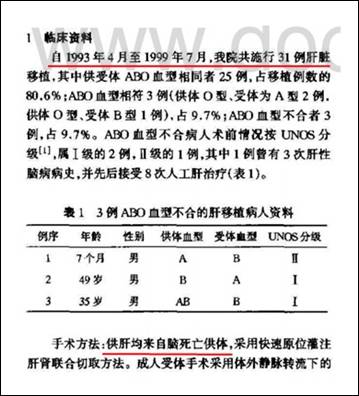
Figure 5. Excerpt of Huang Jiefu’s paper on The Chinese Journal of Practical Surgery, May 2000
4 Issuing deceiving statements to hide unethical medical conduct in China
4.1 November 2006: Most organs were from donation after death
November 14, 2006, Huang Jiefu announced at the National Organ Transplant Clinical Management Summit, “The majority of organs for transplant were from organ donation after death, part of which came from traffic accident victims and families[15].”
4.2 November 2011: Fifty eight percent of the total transplants use executed prisoners’ organs
In his November 2011 article published in the medical journal The Lancet, Huang Jiefu commented: “China is the only country in the world that systematically uses organs from executed prisoners. About 10,000 transplant operations are performed each year in China, among which 65 percent are organs from cadavers, and 90 percent of which are executed prisoners[16],” concluding that 58 percent of the total transplants used executed prisoners’ organs.
Although Huang Jiefu stated that 65 percent of the organs came from cadavers, he did not sufficiently explain where the 35 percent non-cadaveric organs came from. In the west, where voluntary organ donation is well established in society, people naturally think that the 35 percent came from living donors. However, it was in 2010 that China started the first voluntary organ donation trial program. If Huang Jiefu’s claim about 35 percent were true, the organs must have come from non-consenting, living “donors” (i.e., prisoners of conscience). According to a study of Chinese medical papers published between 2000 and 2012, only 24 percent of the organs came from cadavers[17]. During the same time frame, Falun Gong practitioners were the largest group of prisoners of conscience.
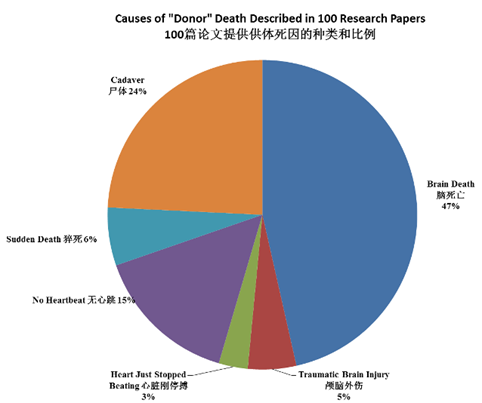
Figure 6: Causes of death analysis of “donors” described in Chinese medical paper published from 2000 to 2012
4.3 March 2012: Executed prisoners are the main source of organs
March 7, 2012, qq.com quoted Huang Jiefu, “The bottleneck of the organ transplant industry in China is the lack of organs. Because there is no donation system, organs from executed prisoners have been the main source for transplants[18].”
4.4 March 2013: Number of executed prisoners decrease by 10 percent per year since 2003
March 7, 2013, Huang Jiefu told Southern Metropolis Daily: “Ten years ago, the number of executed prisoners started to decrease by 10 percent every year. Now, there are in fact very few executed prisoners now[19].”
According to Duihua Foundation, China executed 2,400 people in 2013. The historical number chart provided by duihua.org illustrates the estimated number of executions since 2002[20]. It matches Huang Jiefu’s statement of 10 percent decrease per year.
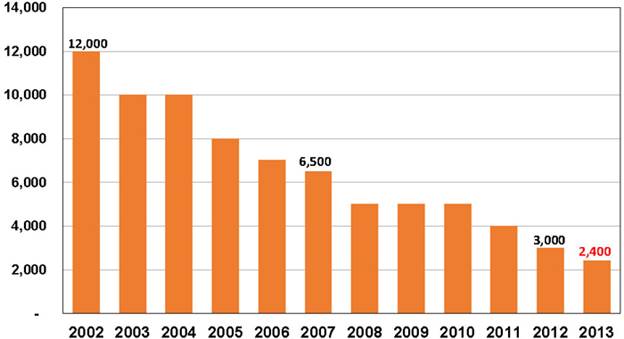
Figure 7: Estimated number of executions in China by duihua.org
4.5 Ending reliance on executed prisoners’ organs by counting prisoners as citizens
March 2012, Huang Jiefu announced in Hangzhou city that China will establish an organ donation program and promised to end the reliance on executed prisoners’ organs in 3 to 5 years[21].
November 2012, In Guangzhou, Huang Jiefu claimed that because of the establishment of an organ donation system, “China will end its reliance on executed prisoners’ organs in 1 to 2 years[22].”
March 2014, Huang Jiefu said, “Executed prisoners are also citizens. We cannot deny their rights to donate organs,” concluding that China will continue to use organs from prisoners. He also indicated that once the executed prisoners are entered into the China Organ Transplant Response System (COTRS) as citizen donations, there would be only one option, namely citizen donation[23]. Within two years, Huang Jiefu made three different statements about the continuation of the organ sourcing from prisoners.
4.6 May 2013: “my own practice has not taken organs from the prisons for two years now”
May 2013, Huang Jiefu’s honorary professorship at the University of Sydney came under fire because of his alleged use of executed prisoners’ organs for transplant. Huang told an overseas media, “In China, the executed prisoner must agree and written consent from the prisoner or family member must be obtained before the organs can be harvested… my own practice has not taken organs from the prisons for two years now.” In the same interview, Huang Jiefu also asked, “why do you object” [to use organs from executed prisoners], suggesting that criticism on sourcing organs from prisoners is not a problem. He claimed, “Policy is being made, within two years, we will completely eliminate the heavy reliance on prisoners' organs[24].”
4.7 March 2014: Use of executed prisoners’ organs without consent ongoing
March 2014, Hong Kong’s Mingpo quoted Huang Jiefu: “Why do we admit it [harvesting organs from executed prisoners]? Because there were no donated organs, it was done systematically. No matter how hard we try to hide it, we can’t. The systematic use of executed prisoners’ organs is operated by hospitals, courts and police, no one can explain (how it works) clearly.” Huang Jiefu also added “we have not been able to obtain consent from the prisoners or the families[25].” This is a direct contradiction to his statement made in May, 2013.
5 Huang Jiefu’s active involvement in the persecution of Falun Gong
Prior to becoming the Vice Minister of Health in 2001, Huang Jiefu was the President and Party Chief at Zhongshan Medical University. In July 1999, when the persecution of Falun Gong began, Huang led the university’s party committee, where students and faculty studied anti-Falun Gong documents issued by the CCP Central, Ministry of Civil Affairs and Ministry of Public Security, and forced to watch TV programs defaming Falun Gong. The Memorial Hospital and public clinics affiliated with the university all followed the lead and organized similar activities[26].
One week after the now proven, staged Tiananmen Square Self Immolation (Jan. 23, 2001), Huang Jiefu told a Guangzhou based newspaper, Yangcheng Evening News, that “struggle against Falun Gong is a serious political campaign. We must have no mercy towards the few active members[27].”
May 2001, Minghui.org (a Falun Gong run website to document the persecution), reported that the campus of Zhongshan Medical University was filled with anti-Falun Gong slogans and banners[28]. Five months later in October 2001, Huang Jiefu, while displaying his alignment to the Party’s political campaign against Falun Gong, was appointed the Vice Minister of Health.
It is incomprehensible and against medical ethics for a doctor to express “no mercy” towards any human being, especially peaceful meditators. Given Huang’s “merciless” attitude towards Falun Gong during his 12-year tenure as Vice Minister, China’s exponential and unexplained increase of transplant numbers would be plausible and coincide with the persecution of Falun Gong and the exploitation of their bodies for organs.
6 Conclusion
Since 2005, Huang Jiefu, the spokesperson on China’s transplantation situation, speaks of limited use of prisoners’ organs, only to contradict himself later with admission that prisoners are the primary source of organs. He writes about brain dead “donors” in medical papers, although there exists no brain death policy in China. He speaks of ending reliance of prisoners’ organs, but states that prisoners are citizens with rights to donate organs, and prisoners will be added to the computerized organ donation registry. He speaks about the use of prisoners’ organs to be unethical, yet he also said “why do you object [taking executed prisoners’ organs]?” Huang Jiefu’s conflicting statements issued under different circumstances display uncertainty about the true situation of China’s transplant practice. The inconsistency reflects patterns of China’s propaganda practice due to Huang’s personal involvement in the nationwide transplant abuse, and to his statements that divert attention and misinform the public. The discrepancy of the statements and data points to an undisclosed pool of organ donors, suggesting the harvesting of organs from living prisoners of conscience as a necessary explanation.
Six years after Huang Jiefu returned from Australia to China, in 1993, he performed “China’s first liver transplant with In vitro venous bypass,” and thus was labeled “the propeller of China’s second wave of liver transplant[29].” Yet, there was no significant improvement in transplantation in the following few years. July 1999, when the Chinese regime’s persecution of Falun Gong began, the “second wave of liver transplant” occurred in China. Since the year 2000, transplant numbers drastically increased, while the execution numbers decreased by 10 percent each year. There was no explanation by a single hospital, committee, or expert in terms of the source of the large amount of extra “donor” organs.
Huang Jiefu should be held accountable for his active involvement in unethical transplant practices, not awarding him honorary titles. The international community should demand explanation from Huang Jiefu concerning the source of several hundred livers that he has transplanted in his professional career.
7 References
All referenced Chinese webpages are archived. Please contact WOIPFG to request a copy.
[1] Sun Yat-sen University website, “Huang Jiefu and Sun Yat-sen University of Medical Science”
http://gjs.sysu.edu.cn/zsdxxs/zxr/12874.htm
[2] Ministry of Human Resources and Social Security of the People's Republic of China, March 12, 2013
http://www.mohrss.gov.cn/SYrlzyhshbzb/zwgk/SYguowuyuanrenmian/201303/t20130322_91828.htm
[3] xinhuanet.com, March 14, 2008 “Huang Jiefu: organ transplant will have a state level control and monitor entity”
http://news.xinhuanet.com/misc/2008-03/14/content_7785194.htm
[4] gov.cn, March 1, 2013 “Human organ transplant regulation effective on March 1”
http://www.gov.cn/fwxx/sh/2013-03/01/content_2342510.htm
[5] sciencenet.cn, March 8, 2014 “Huang Jiefu: only 0.5 out of 1 million people donate”
http://news.sciencenet.cn/htmlnews/2014/3/289619.shtm
[6] Peking Union Medical College Hospital website, About Huang Jiefu
http://www.pumch.cn/Item/1616.aspx
[7] Xinhuanet.com, Sept. 19, 2003, “Huang Jiefu conducted liver transplant in Zhongnan Univ.”
http://news.xinhuanet.com/st/2003-09/19/content_1090034.htm
[8] Urumqi online, Oct. 11, 2005, “Record breaking 2 liver transplants in 25 hours”
http://www.wlmqwb.com/wlmqwb/map/2005-10/11/content_26276.htm
[9] Sina.com.cn, Oct. 3, 2005, “Our country’s first autologous liver transplant was successfully performed in Xinjiang”
http://news.sina.com.cn/s/2005-10- 03/11557091937s.shtml
[10] dayoo.com, Nov. 23, 2012, “Wu Huajing brain dead, father signed donation paper”
http://news.dayoo.com/guangzhou/201211/23/73437_27483097.htm
[11] dayoo.com, March 13, 2013 “Huang Jiefu: salute to donors” Source: Guangzhou Daily
http://news.dayoo.com/guangzhou/201303/13/73437_29475945.htm
[12] Chinese Journal of Surgery, Jan. 2003, Vol.41, Issue 1, “Prevention, diagnosis and treatment of biliary complications after liver transplantation” 原位肝移植术后胆道并发症的预防与诊治, CHEN Guihua, LU Minqiang, HE Xiaoshun, ZHU Xiaofeng, , WANG Guodong, YANG Yang, CAI Changjie, HUANG Jiefu
[13] Chinese Journal of Clinical Nutrition April 2012, Vol.20, Issue 2, “Perioperative nutrition support therapy for combined ‘en bloc’ liver/pancreas transplantation” 肝胰十二指肠器官簇移植围手术期营养支持疗法探讨, JU Weiqiang, ZHOU Jian, HE Xiaoshun, WANG Dongping, ZHU Xiaofeng, WU Linwei, XING Qiang, GUO Zhiyong, HUANG Jiefu
[14] Chinese Journal of Practical Surgery, May 2000, Vol.20, Issue 5, “ABO incompatible liver transplantation” ABO血型不合的肝脏移植, HE Xiaoshun, CHEN Guihua, ZHU Xiaofeng, LU Minqiang, WANG Guodong, HUANG Jiefu
[15] moh.gov.cn, Nov. 14, 2006, “Huang Jiefu’s speech on the national organ transplant clinical management summit”
http://wsb.moh.gov.cn/huanghf/pldjh/200804/30347.shtml
[16] Lancet, November 2011, “A pilot programme of organ donation after cardiac death in China”
http://www.thelancet.com/journals/lancet/article/PIIS0140-6736(11)61086-6/abstract
[17] WOIPFG, Oct. 13, 2014, “Evidence of Live Organ Harvesting of Falun Gong Practitioners Collected from Chinese Medical Papers”
http://www.upholdjustice.org/node/263
[18] Qq.com, March 7, 2012, “vice minister of health: executed prisoners is the main source of organs for transplant in our country”
http://news.qq.com/a/20120307/001217.htm
[19] China transplant network, March 7, 2013, “90% of doctors do not understand brain death, Huang Jiefu thinks brain death regulation not ready”
http://www.transplantation.org.cn/zyienizhonghe/2013-03/6553.htm
[20] Duihua Foundation, Oct. 20, 2014, “China Executed 2,400 People in 2013, Dui Hua”
http://duihua.org/wp/?page_id=9270
[21] xinhuanet.com, March 22, 2012, Ministry of Health promises solution to executed prisoners’ organs in 5 years
http://news.qq.com/a/20120322/001592.htm
[22] chinanews.com, Nov. 21, 2012 “China will stop using executed prisoners’ organ in 1 to 2 years”
http://finance.chinanews.com/jk/2012/11-21/4347626.shtml
[23] Sciencenet.cn, March 8, 2014, “Huang Jiefu: only 0.5 out of 1,000,000 people donate organs”
http://news.sciencenet.cn/htmlnews/2014/3/289619.shtm
[24] ABC News, May 21, 2013, “Australian-trained doctor Huang Jiefu hits back at critics over ties to China organ harvesting”
http://www.abc.net.au/news/2013-05-20/chinese-doctor-hits-back-at-critics-over-organ-donation-program/4701436
[25] wenxuecity.com, source Mingpo, March 11, 2014 “High ranking CCP official: we have never stopped using executed prisoners’ organs”
http://www.wenxuecity.com/news/2014/03/11/3088771.html
[26] Zhongshan Medical University Newsletter by the President’s Office, 1999 No. 18 (vol. 388)
http://www.gzsums.edu.cn/news/9918.htm (already deleted, archived link below)
http://web.archive.org/web/20040924183121
[27] Changcheng Evening News, Feb. 2, 2001, “Scholars from Guangdong Universities … ‘self-immolation incident’”
http://ycwb.com.cn/gb/content/2001-02/02/content_128063.htm
[28] minghui.org, May 15, 2001, “President of Zhongshan Medical University Defames Falun Gong”
http://www.minghui.org/mh/articles/2001/5/15/11086.html
[29] Organ Transplant Center, Sun Yat-sen University No.1 Hospital website, “About the Center”
http://www.transplant-china.com/about/columnsId=2%253FcolumnsId=2.html


